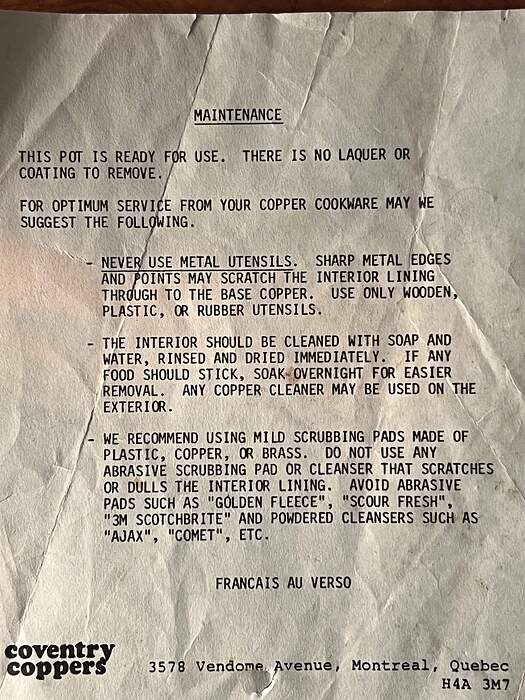I recently got a nice 11" frying pan. It is about 2 mm thick copper, has a cast iron handle, and was billed as stainless lined. I got it to have a good sized frying pan that anyone could use without fear of messing up a tin wipe. The sheen of the lining looked odd, but I went ahead and christened the pan with an acidic “clean out the fridge” sauce of soffrito made in olive oil, sliced old cremini, pancetta, Italian sausage, hand crushed SMs, garlic, oregano, black pepper, a smidge of tomato paste, an anchovy filet , and a hearty dosing of NP dry vermouth. It got a bit of salty pasta water and ended up in a bowl of al dente pappardelle. After tossing and plating it got a bit of grated Pec Rom. After dinner as I went about cleanup, I noticed a slight bluish black discoloration of the lining, not something I am used to seeing with SS. Once the pan was clean and dry, I gave it the refrigerator magnet test. Yes, it was ferromagnetic but with nowhere near the strength that SS exhibits. My conclusion is that it is a nickel lining. I am actually kind of glad it is nickel and not SS. It was a good price, is a good size, and is still pretty tough, even in the face of steel tools. In my dotage, I am finally getting right with nickel.
2 Likes
Some stainless steel is not strongly magnetic. Depends on the ratios of iron to chromium to nickel. Austenitic steel (304 or 316) has so little iron in it that it can be totally nonmagnetic, although it can get weakly magnetic with high heat or with cold working. I’m thinking that’s probably what you have. In that case, the bluish cast isn’t so much from the nickel content as from the chromium content.
1 Like
Thanks.
I have a Coventry Coppers (defunct Montreal manufacturer) sauté pan from 1981 or 1982 that is nickel-lined. I had no idea what it was lined with when I bought it; I just treated it gently and honestly didn’t use it all that often. It’s retired now that I have an induction stove.
How I kept up with that scrap of paper I’ll never know.



